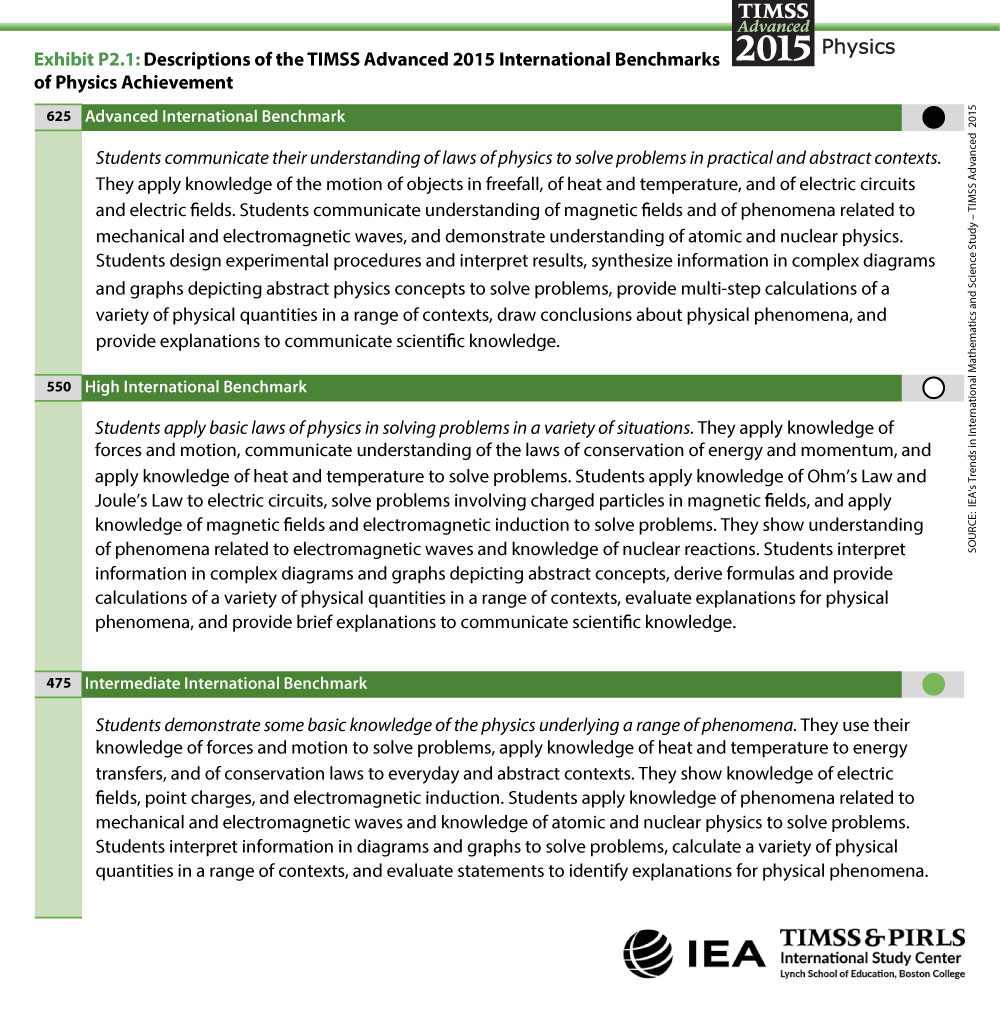TIMSS Advanced 2015 International Benchmarks of Physics Achievement
As a way of interpreting the scaled achievement results, three points on the physics achievement scale were identified as international benchmarks—Advanced (625), High (550), and Intermediate (475). The TIMSS & PIRLS International Study Center worked with the TIMSS 2015 Science and Mathematics Item Review Committee (SMIRC) to conduct a detailed scale anchoring analysis to describe physics achievement at the benchmarks and to select example items to illustrate the physics content and types of cognitive processing skills and strategies demonstrated by students at each of the international benchmarks. For the items designated for use in reporting the results, every effort was made to include examples that not only illustrated the particular benchmark under consideration, but also represented different item formats and content area domains.
Item Map

INTERNATIONAL BENCHMARKS
Advanced International Benchmark (625)
Advanced International Benchmark (625)Students communicate their understanding of laws of physics to solve problems in practical and abstract contexts.They apply knowledge of the motion of objects in freefall, of heat and temperature, and of electric circuits and electric fields. Students communicate understanding of magnetic fields and of phenomena related to mechanical and electromagnetic waves, and demonstrate understanding of atomic and nuclear physics. Students design experimental procedures and interpret results, synthesize information in complex diagrams and graphs depicting abstract physics concepts to solve problems, provide multi-step calculations of a variety of physical quantities in a range of contexts, draw conclusions about physical phenomena, and provide explanations to communicate scientific knowledge.
More about this benchmark >
High International Benchmark (550)
High International Benchmark (550)Students apply basic laws of physics in solving problems in a variety of situations. They apply knowledge of forces and motion, communicate understanding of the laws of conservation of energy and momentum, and apply knowledge of heat and temperature to solve problems. Students apply knowledge of Ohm’s Law and Joule’s Law to electric circuits, solve problems involving charged particles in magnetic fields, and apply knowledge of magnetic fields and electromagnetic induction to solve problems. They show understanding of phenomena related to electromagnetic waves and knowledge of nuclear reactions. Students interpret information in complex diagrams and graphs depicting abstract concepts, derive formulas and provide calculations of a variety of physical quantities in a range of contexts, evaluate explanations for physical phenomena, and provide brief explanations to communicate scientific knowledge.
More about this benchmark >
Intermediate International Benchmark (475)
Intermediate International Benchmark (475)Students demonstrate some basic knowledge of the physics underlying a range of phenomena. They use their knowledge of forces and motion to solve problems, apply knowledge of heat and temperature to energy transfers, and of conservation laws to everyday and abstract contexts. They show knowledge of electric fields, point charges, and electromagnetic induction. Students apply knowledge of phenomena related to mechanical and electromagnetic waves and knowledge of atomic and nuclear physics to solve problems. Students interpret information in diagrams and graphs to solve problems, calculate a variety of physical quantities in a range of contexts, and evaluate statements to identify explanations for physical phenomena.
More about this benchmark >

EXAMPLE ITEMS
ITEM 1
Example Item 1Evaluates a mechanical system run by an electric motor and predicts the difference between the theoretical and actual final temperatures of the system
More about this item >
ITEM 2
Example Item 2Analyzes a complex circuit diagram to determine the power consumption of light bulbs
More about this item >
ITEM 3
Example Item 3Identifies the prediction for the change in the path of a horizontal electron beam as a result of the presence of a magnetic field
More about this item >
ITEM 4
ITEM 1
Example Item 1Derives an expression for the speed at the top of the trajectory of an object moving in a vertical circular path
More about this item >
ITEM 2
Example Item 2Shows the steps in a calculation of the final velocity of two skiers after they collide inelastically
More about this item >
ITEM 3
Example Item 3Shows the steps in a calculation of the amount of energy required to increase the temperature of water in a given context
More about this item >
ITEM 4
Example Item 4Ranks the equivalent resistance of four different combinations of resistors
More about this item >
ITEM 5
Example Item 5Explains which semiconductor is appropriate to use in a solar panel, given a graph of the performance of each semiconductor across a range of wavelengths of light
More about this item >
ITEM 1
Example Item 1Selects the graph that best represents the potential energy of a ball rolling up and down an inclined plane
More about this item >
ITEM 2
Example Item 2Identifies the direction of the force on a point charge in various positions in an electric field
More about this item >
ITEM 3
ITEM 4
ITEM 5
Example Item 5Completes a table to indicate the number of protons and neutrons in given isotopes
More about this item >
Summary
You may also be interested in...



